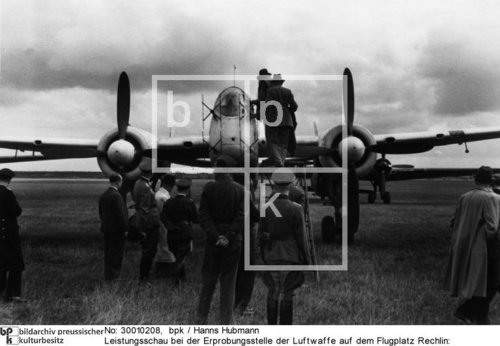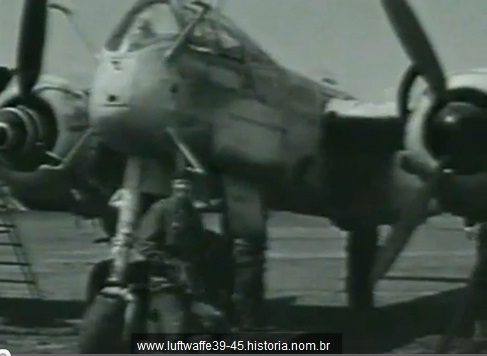Contents include chapters devoted to production and Werknummern, an analysis of oft-published and erroneously captioned photos while the bulk of the work (P23-90) reviews all published works on the He 219 with corrections. There are no fewer than 63 detailed corrections and textual improvements for the most recent work on the type, Marek Murawski's He 219 Uhu monograph recently published by Kagero. The appendices cover Werknummern and Stammkenzeichen, victory claims and losses and a comprehensive bibliography.
Asserted by many historians and enthusiasts to have been the leading nightfighter of WWII, the vaunted He 219 was undoubtedly a dangerous opponent for RAF Bomber Command heavies, but rather less so than is often proclaimed for the RAF's rapid twin-engine Mosquito. While prototypes featured - or were intended to feature - remotely controlled gun barbettes, ejection seats and other exotic innovations, most of these developments had been dropped by the time the type entered service. The He 219 was nonetheless fast, heavily armed, had reasonably effective radar and offered outstanding visibility and safety to its crews due to the tricycle undercarriage and ejection seats as detailed in and according to an official 1. Jagddivision report compiled from interviews of I./NJG 1 personnel. (text extract from the von Rohden collection below)
The destructive start to the He 219's night-fighting career with I./NJG 1 is well known, although the feats ascribed to the type subsequently are somewhat exaggerated. During May 1943 the Stab I./NJG 1 received three pre-production A-0s (the V7, the V8 and the V9) for operational testing. All three of these aircraft were similarly armed with two MG 151/20 in the wing roots and four 30 mm MK 108 cannon in the ventral weapons bay. Few if any He 219s ever mounted the Mk 103 cannon. The aircraft were fitted with the FuG 202 Lichtenstein radar. It is known that Maj. Werner Streib's He 219 was destroyed in a crash landing after his first operational interceptions on the night of 11-12 June 1943 when he claimed five bombers in WNr. 190009 (coded G9+FB). Following this loss the He 219 V10 and He 219 V12 were delivered to I./NJG 1 at Venlo in July/August 1943 and the first of the A-0 preproduction series (WNrn. 190051 and 190053) were delivered in the first week of September 1943. On 1 July Hptm. Hans- Dieter Frank had taken over the reins at I./NJG 1 and claimed seven British bombers between 25-26 July and 5-6 September at the controsl of a He 219. He was killed on the night of 27-28 September when his He 219 was involved in a mid-air collision with a Me 110 G-4 of the Geschwaderstab NJG 1. The first Mosquito shot down by a He 219 from I./NJG 1 was no earlier than 6/7 May 1944 through Oblt. Werner Baake, I./NJG 1 eventually accounting for no more than twelve (12) Mosquitos during the existence of the Gruppe. The first crew to save their lives with the ejection seats (then called Katapult Anlage, lit. catapult apparatus) was Uffz. Perbix and his Bordfunker on the night of 10-11 April 1944.
A large number of published images of the He 219 have been blighted by incorrect and inappropriate captions, especially of the He 219 V5 (above). Taken in the spring of 1943 shortly after coming off the assembly line at Schwechat this is WNr. 190005 coded DH+PU. Note the 'step' in the rear lower fuselage (similarly in the upper fuselage although not visible here) Effective from WNr. 190007 the rear fuselage of the He 219 was stream-lined with the removal of the 'steps'.
Previously on this blog I wrote that the He 219 seen at Rechlin during the Luftwaffe's September 1943 equipment exhibition was the He 219 V4 based on Peter Petrick's photo caption in Jet & Prop. Herewith Ron's assessment of that information;
Is the machine likely to be the He 219 V4?
Answer – No. Why? The historical record and the photographic record show that the He 219 V3, V4, V5 and V6 had a very different rear fuselage to all other He 219s. The first six He 219s (V1 to V6, inclusive) were constructed with the originally designed fuselage, which included ‘steps’ in the upper and lower fuselage (intended for remotely controlled gun barbettes). Problems detected in the early flights of the V1 (excessive tail vibrations and flight instability) led to a series of modifications to the V1 in December 1942 and early 1943. These modifications included (a) lengthening the rear fuselage by 940 mm, (b) removal of the ‘steps’ in the rear fuselage, (c) thickness of the fuselage skinning increased by 30% in selected areas, (d) engine nacelles lengthened, and (e) original empennage replaced by a redesigned, larger tail unit. The same modifications were made to the He 219 V2 in early 1943. At the same time it was decided all He 219s commencing from the He 219 V7 would incorporate these design changes ex-factory assembly line. The prototypes V3 to V6, inclusive, were fitted with the larger, redesigned tail unit but did not receive modifications to the fuselage. If you look at the attached photos of the He 219 V5 and compare them against Hubmann’s photos you’ll see the significant difference in the rear fuselage. The ‘step’ in the lower rear fuselage of the He 219 V5 is obvious; not so easy to see is the corresponding 'step' in the upper fuselage (poor photo quality, I’m afraid).
Is the machine likely to be the He 219 V8?
Answer – Yes. Why? Firstly, we feel certain this machine is the He 219 V7 or later. Secondly, we can account for the whereabouts of all the early prototypes (from the V7 up to V12) through the period late August/early September 1943 – and we can safely rule out the V7, V9 (lost in combat June 43), V 10, V 11 and V12 (after that point, we're into the A-0 pre-production machines which are well documented).
We know that the He 219 V8 was delivered to I./NJG 1 at Venlo in May 1943 (see notes above). On 15 May a comparison flight was flown between the He 219 V8 and a Bf 110G (Remp, p.63). We further know that the V8 was subsequently transferred to Rechlin (date uncertain) for undercarriage trials (the RLM were not at all convinced by the He 219's tricycle undercarriage). In Hubmann’s photos you will see a strange looking device under the belly of the He 219. Thanks to Marcel’s detective work, it is now known that this device is a camera or some sort of ‘Gerät’ for monitoring the retraction and extension of the landing gear. This ties up with a work report (Werksbericht) of 10 July 1943 linking the V8 to the installation of meters for nosewheel travel (again, thanks to Marcel H).
Question – the He 219 V 4?
On 19 April 1943 a telex was sent from Heinkel Vienna to Heinkel Jenbach (Tyrol) advising that, quote, “A representative from Rechlin will be here tomorrow to collect the V4 and ferry it to Rechlin.” (Remp, p.57). Later reports (August & September 1943) of the V4 talk of engine and cooling system troubles; there is no word about landing gear tests. Some He 219 publications state that the V4 was connected to ejection seat testing – although having researched this, I am strongly of the view that this is incorrect. You can read more about this in my forthcoming 2nd Edition of The Research Paper. The He 219 V4 can certainly be linked with testing at Rechlin – but, it was only one of a number of He 219s linked with Rechlin.
Conclusion;
Marcel and I are strongly of the view that the He 219 seen in Hubmann’s photographs is the He 219 V8, Werknummer 190008. (See photo below - note the re-designed and streamlined rear fuselage visible in this view) The Stammkennzeichen is not known for certain but is almost certainly DH + PX.
A message from Ron;
".. This 2nd Edition of my Research Paper will be my final act before going into retirment. I simply could not rest without tidying up the matters raised in the initial publication. I have no plans for a 3rd Edition and once this 2nd Edition is put into circulation I intend to wind down. Briefly, I want to take this opportunity to explain my reasons for this action: -
The Research Paper has been quite critical of previous He 219 publications for the many errors of fact, confusions and misunderstandings that appear in those publications. Even though the Research Paper was an attempt to make sense of it all, it too contains errors of fact, confusions and misunderstandings. Because I am aware of those shortcomings, I feel very strongly I have a responsibility to set right my previous work.
Most important to me, however, is the fact that the Research Paper is dedicated to the memory of my son, Stuart. For this reason alone, I could not rest knowing that the Research Paper as originally published earlier this year contains errors.
The 2nd Edition is a huge step up from the first Edition; pages have increased from 75 to 110. The text has been reworked from front cover to back cover and the necessary corrections/amendments have been made - this includes an additional 20,000 words. My old dinosaur of a computer struggled with graphics and images but thanks to a major upgrade in this area, photographs which were sadly lacking in the 1st Edition are now included in a separate Chapter and elsewhere throughout the book. A limited number of copies have been printed. In lieu of a charge- and if you feel so inclined - a donation to your favourite charity would be very much in order. Nowadays my favourite charity is homeless kids (55 years ago I was a homeless kid)..."













